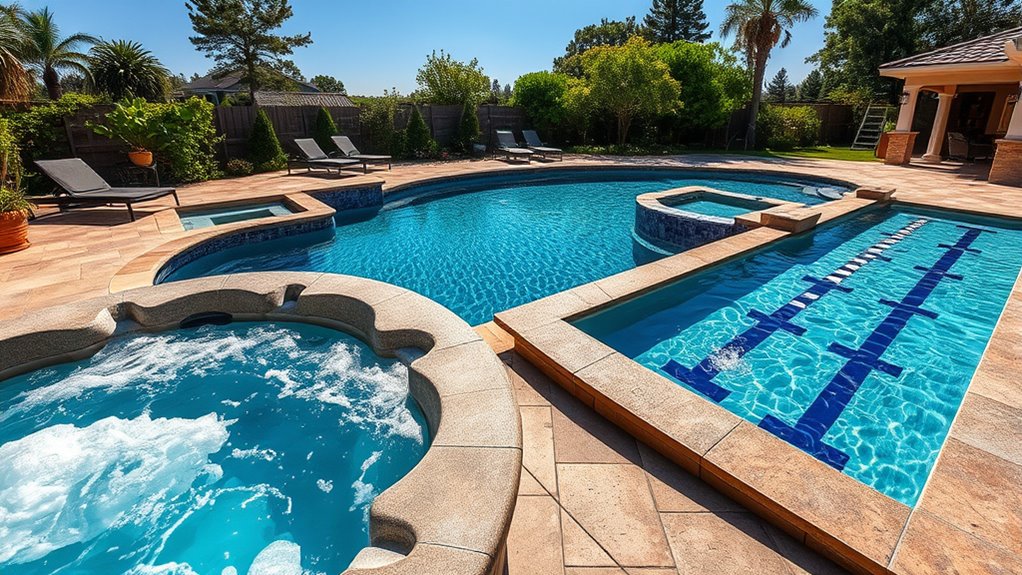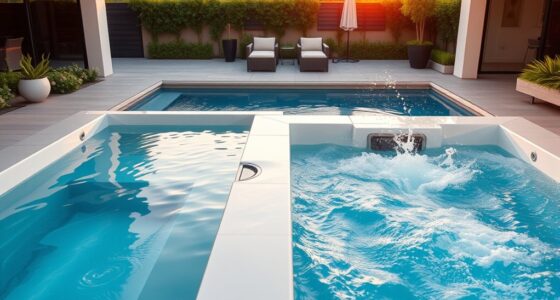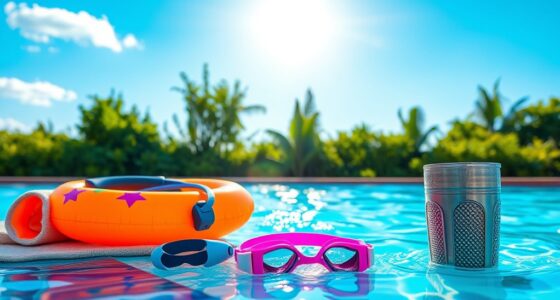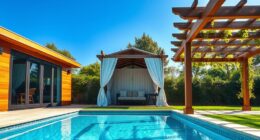Choosing between a hot tub, swim spa, and pool depends on your lifestyle, space, and budget. If you want relaxation with warm jets, a hot tub is ideal, while a swim spa combines exercise with soothing features in a smaller space. A pool offers extensive recreational and social opportunities but requires more investment and maintenance. To find the perfect fit for your home and enjoy water luxuries tailored to your needs, explore the details ahead.
Key Takeaways
- Hot tubs are compact and ideal for relaxation, while swim spas combine exercise and leisure in a single unit.
- Pools offer extensive space for swimming and social gatherings but require larger areas and higher costs.
- Swim spas are more energy-efficient and easier to maintain than hot tubs and traditional pools.
- Hot tubs have lower initial costs but higher ongoing maintenance expenses compared to swim spas.
- Design choices depend on space availability, usage goals, and budget considerations for home water luxuries.

Are you trying to decide between a hot tub, a swim spa, or a traditional pool for your backyard? Choosing the right water feature depends on your lifestyle, budget, and how much you want to invest in upkeep. When it comes to energy efficiency, hot tubs typically consume more energy than swim spas or pools because they’re designed to keep water warm for soaking purposes. Swim spas, however, tend to be more energy-efficient since they combine exercise and relaxation features in a single unit and often have better insulation. Traditional pools can vary widely in energy efficiency depending on their size, design, and whether they use energy-efficient pumps or heaters, but they generally require more energy to maintain larger volumes of water at the desired temperature.
Maintenance costs are another essential factor. Hot tubs usually have higher maintenance costs per year because they require regular water treatment, filter changes, and occasional parts replacements. They are smaller, so the water needs to be circulated and sanitized more frequently to prevent bacteria growth. Swim spas, being slightly larger, still require routine maintenance, but their integrated filtration systems often make upkeep more manageable. Pools, especially larger ones, can be costly to maintain due to the volume of water, the need for continuous filtration, and chemical treatments. They also often demand more frequent cleaning, equipment checks, and winterization in colder climates, which adds to ongoing expenses.
Your choice should also consider how often you plan to use the feature. If you want a cozy spot for relaxing after work or unwinding with a few friends, a hot tub might be perfect. It offers warm, soothing jets that promote relaxation and muscle relief. If your goal is to stay active and swim laps, a swim spa combines the benefits of a pool and a hot tub, allowing for exercise and relaxation without the extensive maintenance of a full-sized pool. For those who love hosting gatherings or want a large area for recreation, a traditional pool provides ample space for swimming and socializing, though it comes with higher initial costs and ongoing maintenance.
Frequently Asked Questions
Which Water Feature Requires the Least Maintenance?
You might wonder which water feature needs the least maintenance. Generally, pools require less chemical upkeep and cleaning frequency compared to hot tubs or swim spas. Pools have larger volumes of water, which dilute chemicals and reduce the need for frequent balancing. Hot tubs and swim spas, with smaller water capacities, demand more regular chemical adjustments and cleaning to keep the water clear and safe. So, for minimal maintenance, a pool is your best choice.
Can These Water Features Be Used Year-Round?
You can definitely use these water features year-round, but seasonal usability and climate adaptability vary. Hot tubs are great for winter, offering warmth regardless of outdoor temperatures. Swim spas also adapt well to colder climates if equipped with heating. Pools, however, might be less practical in winter unless you have a heated or indoor setup. Consider your local climate to make sure each feature meets your seasonal needs and remains enjoyable year-round.
What Are the Safety Considerations for Each Option?
When considering safety, you should prioritize chemical safety and electrical hazards. Always store chemicals properly and follow manufacturer instructions to prevent skin or eye irritation. Confirm electrical components are installed by professionals, and keep all wiring away from water to avoid shocks. Regularly inspect your water feature for leaks or damage, and use safety covers when not in use. Staying vigilant helps you enjoy your water feature safely year-round.
How Much Does Installation Typically Cost?
Installation costs vary depending on the water feature you choose and your home’s setup. Hot tubs usually cost between $3,000 and $8,000, including installation. Swim spas range from $10,000 to $20,000, while pools can start at $10,000 and go much higher. You should consider your budget considerations carefully, as factors like site preparation, permits, and additional equipment impact overall costs. Planning ahead helps you stay within your financial limits.
Are There Environmental Impacts Associated With Each?
Did you know that pools can use up to 1,000 gallons of water weekly? When considering environmental impacts, hot tubs, swim spas, and pools all affect your surroundings through energy consumption and water usage. Hot tubs often require significant energy for heating, while pools need frequent water refills. Swim spas balance both, but all three options have environmental footprints. Being mindful can help you reduce energy and water waste.
Conclusion
Choosing between a hot tub, swim spa, or pool depends on your lifestyle and desires. A hot tub offers relaxation and intimacy, while a swim spa combines exercise with leisure, and a pool provides endless fun and social opportunities. Each brings its unique benefits, but the decision ultimately reflects your priorities—whether unwinding, staying active, or entertaining. Whichever you pick, you’ll create a luxurious oasis that enhances your home and enriches your life.









